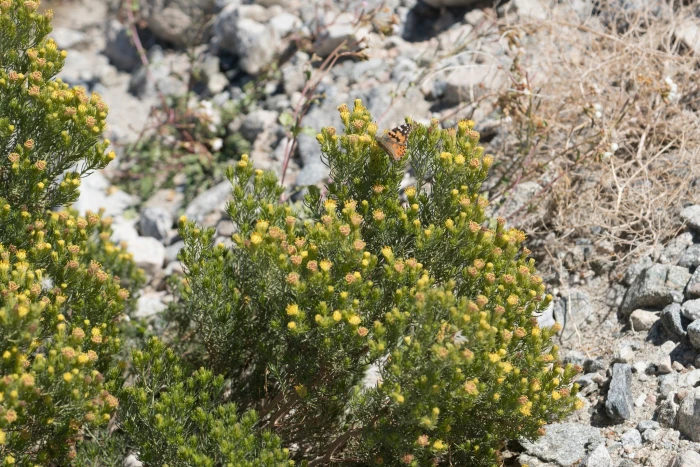Schott’s Pygmycedar
(Peucephyllum schottii)
Schott’s Pygmycedar (Peucephyllum schottii)
/
/

Jesse Rorabaugh
Public Domain
Image By:
Jesse Rorabaugh
Recorded By:
Copyright:
Public Domain
Copyright Notice:
Photo by: Jesse Rorabaugh | License Type: Public Domain | License URL: http://creativecommons.org/publicdomain/zero/1.0/ | Rights Holder: Jesse Rorabaugh | Publisher: iNaturalist | Date Created: 2019-02-18T12:04:16-08:00 |




















































Estimated Native Range
Climate Requirements for Morgantown, West Virginia
| This Plant | Your Site | Plant Suitability for Your Location | ||
|---|---|---|---|---|
| • Precipitation | 2" - 30" | 42" | Aquatic | Aquatic |
| • High Temp. | 79°F - 114°F | 84°F | Your summer temperatures are normal for this plant. | Excellent |
| • Low Temp. | 17°F - 53°F | 21°F | Your winter temperatures are normal for this plant | Excellent |
This plant may not grow well at your location - your precipitation is too high.
Summary
Peucephyllum schottii, commonly known as Schott’s Pygmycedar, is an evergreen shrub native to arid desert regions, specifically the Mojave and Sonoran Deserts in the Southwestern United States and Northwestern Mexico. It is well-adapted to harsh, dry environments and typically grows to a height of 2-5 feet (0.6-1.5 meters) and a width of 2-6 feet (0.6-1.8 meters). Schott’s Pygmycedar has a compact, rounded form with dense, scale-like foliage that provides a unique texture in the landscape. The shrub produces inconspicuous yellow flowers primarily in the winter to summer months, which are followed by small, woody fruits.
Schott’s Pygmycedar is valued for its drought tolerance and ability to thrive in extreme conditions, making it an excellent choice for xeriscaping and desert gardens. It is also used for habitat restoration in its native range. In cultivation, it requires minimal maintenance, needing only full sun exposure and well-drained soils. It is tolerant of a range of soil types, from sandy to rocky, as long as they provide good drainage. While it can survive on low water once established, moderate irrigation can encourage more vigorous growth. There are no widely known cultivars of this species, and it is relatively free of serious pests and diseases. However, overwatering or poor drainage can lead to root rot. Gardeners should be aware that this plant’s natural growth form and size make it unsuitable for small spaces or as a formal hedge.CC BY-SA 4.0
Schott’s Pygmycedar is valued for its drought tolerance and ability to thrive in extreme conditions, making it an excellent choice for xeriscaping and desert gardens. It is also used for habitat restoration in its native range. In cultivation, it requires minimal maintenance, needing only full sun exposure and well-drained soils. It is tolerant of a range of soil types, from sandy to rocky, as long as they provide good drainage. While it can survive on low water once established, moderate irrigation can encourage more vigorous growth. There are no widely known cultivars of this species, and it is relatively free of serious pests and diseases. However, overwatering or poor drainage can lead to root rot. Gardeners should be aware that this plant’s natural growth form and size make it unsuitable for small spaces or as a formal hedge.CC BY-SA 4.0
Plant Description
- Plant Type: Shrub
- Height: 1.5-5 feet
- Width: 1.5-6 feet
- Growth Rate: Slow
- Flower Color: Yellow
- Flowering Season: Winter, Spring, Summer
- Leaf Retention: Evergreen
Growth Requirements
- Sun: Full Sun
- Water: Low
- Drainage: Medium, Fast
Common Uses
Drought Tolerant, Low Maintenance, Potted Plant, Rock Garden
Natural Habitat
Arid desert regions, specifically the Mojave and Sonoran Deserts
Other Names
Common Names: Pygmy-Cedar, Sprucebush, Desert Fir, Desert Pine
Scientific Names: Peucephyllum schottii, Peucephyllum schottii var. latisetum, Psathyrotes schottii, Inyonia dysodioides, Peucephyllum schottii var. schottii, Pleucephyllum schottii
GBIF Accepted Name: Peucephyllum schottii A.Gray